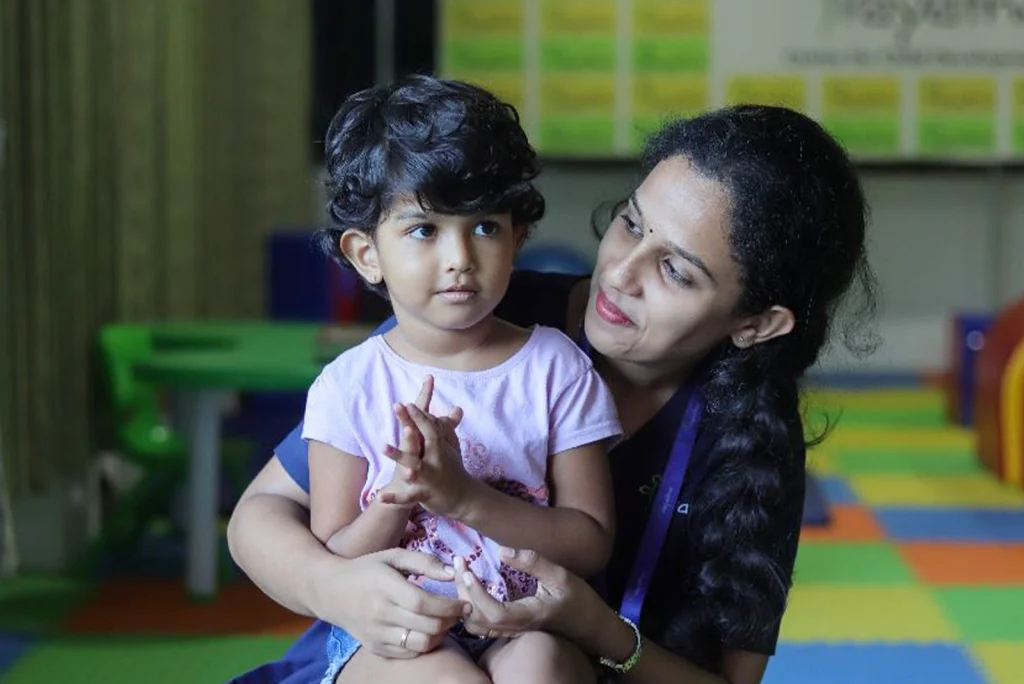
Clinically Reviewed by
Divya Krishna
M Sc (Psy), M Phil Rehabilitation Psychology, PECS Level-1, Certified in Special Education (Learning Disability),
QBA, IBA
Rehabilitation Psychologist and ABA Therapist

“Are you struggling to manage your child’s outbursts? Or concerned about their difficulty in adjusting to social situations? Or perhaps, finding it challenging to teach your child self-care and self grooming skills?”
Whatever your difficulties with your child’s behaviour may be, ABA therapy provides scientifically backed guidance and positive outcomes to help your child learn and thrive.
While outbursts and social difficulties are common amongst kids, they can become overwhelming and even distressing when they go beyond your control. This is especially true if your child is diagnosed with Autism. While ABA therapy can help individuals of any age, it is specifically a tested and proven early intervention approach in autism treatment. Would you like to know how? Let’s read further!
What Is ABA Therapy?
Applied Behaviour Analysis (ABA) Therapy is a scientific approach to understanding behaviour and developing skills to manage the behaviour to get desired outcomes. ABA therapy can help children with autism learn to communicate with others and acquire skills they can utilize for the rest of their lives.
How Does ABA Therapy Work?
ABA Therapy is based on psychological principles of learning theory and focuses on the 4 central attributes of behaviour such as,
- Behaviour is controlled by consequences
- Reward or reinforcement strengthens or increases behaviour
- Punishment or neglect decreases or weakens behaviour
- Environment influences behaviour
Let’s further explore the several steps involved in ABA therapy:
Assessment: The ABA therapist performs an in-depth assessment of the child’s skills and preferences. This helps in understanding the child’s strengths and identifies the areas that need improvement.
Goal setting: Based on the assessment, goals are set in discussion with the parent/caregiver. ABA therapy utilizes SMART goals – Specific, Measurable, Achievable, Relevant and Time-bound goals which ensure that the objectives are clear and trackable making the whole process highly effective and transparent.
Intervention: ABA therapist deploys intervention strategies designed for the specific needs of each child. These strategies are implemented to reduce problem behaviours and teach new skills. It involves breaking down the tasks into smaller and manageable steps.
Monitoring and Evaluation: The child’s progress during therapy is continuously monitored and evaluated. Modifications are made by the therapist wherever required to ensure the effectiveness of the therapy.

ABA Techniques
Antecedent-Behaviour-Consequence
A-B-C helps in understanding – why a behaviour is happening and how different consequences can affect or influence the likelihood of repeating the behaviour.
Upon close observation and analysis of a child’s activities, ABA therapist determines the cause or the ‘trigger’ that leads to specific behaviours and plans on a consequence that would help to increase or decrease repetition of those behaviours in future. This systematic approach helps reduce problem behaviours and encourage positive behaviours.
For achieving desired change in behaviour, ABA therapists use different techniques which include Positive reinforcement, negative reinforcement, prompting and fading, task analysis, generalization, behaviour contracts, video modelling, picture exchange communications teaching, etc.
Positive Reinforcement
Positive reinforcement is one of the main strategies in ABA. When behaviour is followed by a reward that is valued, the person is more likely to repeat the behaviour. This encourages positive behaviour change.
In this technique, first the therapist identifies a goal behaviour. Every time the child exhibits the desired behaviour or skill successfully, he gets a reward – the reward is something the child values, for ex. a toy, praise, time in playground, story time or screen time, colouring etc. This continues to encourage the child to repeat the behaviour which will eventually lead to meaningful behaviour change.
Functional Communication
Functional Communication refers to the ability to communicate one’s feelings and basic needs effectively. When children learn functional communication, they may no longer demonstrate challenging behaviours. To achieve this, we must teach communication strategies that serve the same purpose as the behaviour.
By training parents and caregivers on the intervention strategies, continuing ABA therapy at home becomes much easier. This makes the intervention more effective.
To know more about ABA strategies at home, read “How to Implement effective ABA strategies at Home“
Skills ABA Therapy Can Help Address
ABA therapy can assist in developing a wide range of skills, including but not limited to:
- Communication Skills: Improving verbal and non-verbal communication.
- Social Skills: Enhancing interaction with peers and adults.
- Academic Skills: Developing learning and supporting academic performance.
- Self-Care Skills: Teaching daily living activities like dressing, grooming, and toileting.
- Motor Skills: Developing fine and gross motor abilities.
- Behavior Management: Reducing challenging behaviors and encouraging positive behaviors.

Pros of Applied Behaviour Analysis
Individualized Treatment Plant: Applied behaviour analysis therapy looks different for each child. Personalized goals are set depending on the child’s struggles, strengths and needs.
Evidence-based Therapy: There are several studies that highlight the effectiveness of ABA therapy, especially for children with Autism. For example, the landmark study by Lovaas, O. I. (1987), detailed the positive impact of intensive ABA therapy on young children with autism, presenting significant improvements in IQ and adaptive behaviors. (Lovaas, O. I. (1987) “Behavioral treatment and normal educational and intellectual functioning in young autistic children.” Journal of Consulting and Clinical Psychology, 55(1), 3-9.) https://psycnet.apa.org/doiLanding?doi=10.1037%2F0022-006X.55.1.3
Skill Generalization: ABA therapy helps apply learned skills in different environments and contexts thus promoting independence and adaptability.
Broad Application: ABA therapy can help in,
- Autism
- Attention Deficit Hyperactivity Disorder (ADHD)
- Obsessive-Compulsive Disorder
- Fears
- Phobias
- Issues with anger management
- Anxiety
- Depression


ABA therapy programs can help
ABA therapy programs can significantly enhance the quality of life of individuals by:
Improving Communication: Promotes better expression of emotions, needs and wants.
Enhancing Social Interactions: Helps develop meaningful relationships and interactions with others.
Increasing Independence: Imparts self-help skills that allow for greater independence in daily activities.
Reducing Maladaptive Behaviors: Helps in decreasing behaviors that interfere with learning and socialization.
Academic Support: Offers strategies to support learning and academic success.
Attention: Uses various strategies such as structured tasks to help improve attention skills.
Play: ABA therapy utilizes play-based interventions to promote social skills, communication and cognitive skills.
Impact of Applied Behaviour Analysis on Health
ABA therapy can have a profound impact on an individual’s overall health and well-being. Let’s see how:
Emotional Well-Being: Successful skill acquisition and positive reinforcement helps in improving self-esteem and confidence.
Physical Health: Helps in developing self-care skills and promoting motor skills development.
Mental Health: Helps in reducing anxiety and frustration by teaching coping and communication strategies.
Quality of Life: Helps in enhancing daily functioning and the ability to engage in meaningful activities.

Who provides ABA treatment in Kerala?
ABA therapy in Kerala is provided by,
QABA qualified ABA therapists: Highly trained professionals who design and supervise ABA programs.
ABA Technicians: Individuals who are certified to practice as ABAT work directly with clients under the supervision of a qualified ABA therapist.
In online therapy, the parent/caregiver is trained by the professional to help the child after an in-depth assessment.
Although only qualified professionals are authorized to provide ABA therapy, unauthorized practitioners do exist. Please make sure to verify the license, qualifications, and experience of the ABA therapist before beginning treatment to ensure effective therapy and safe care for your child.

Conclusion
Behaviour is important because it defines us. It affects and is affected by anything or everything around us. Behaviour Analysis helps us understand how behaviour is affected or influenced by the environment and how learning takes place in an individual. In Applied Behaviour Analysis(ABA), the analysis happens in real life situations which helps us understand and modify human behaviour. ABA therapy is a flexible treatment with a scientific and functional approach which can be customized to suit individual skills and needs. It can be provided in multiple locations – at home, at school and in community. It’s structured, scaleable and scientific approach makes it totally acceptable and reassuring for parents.

